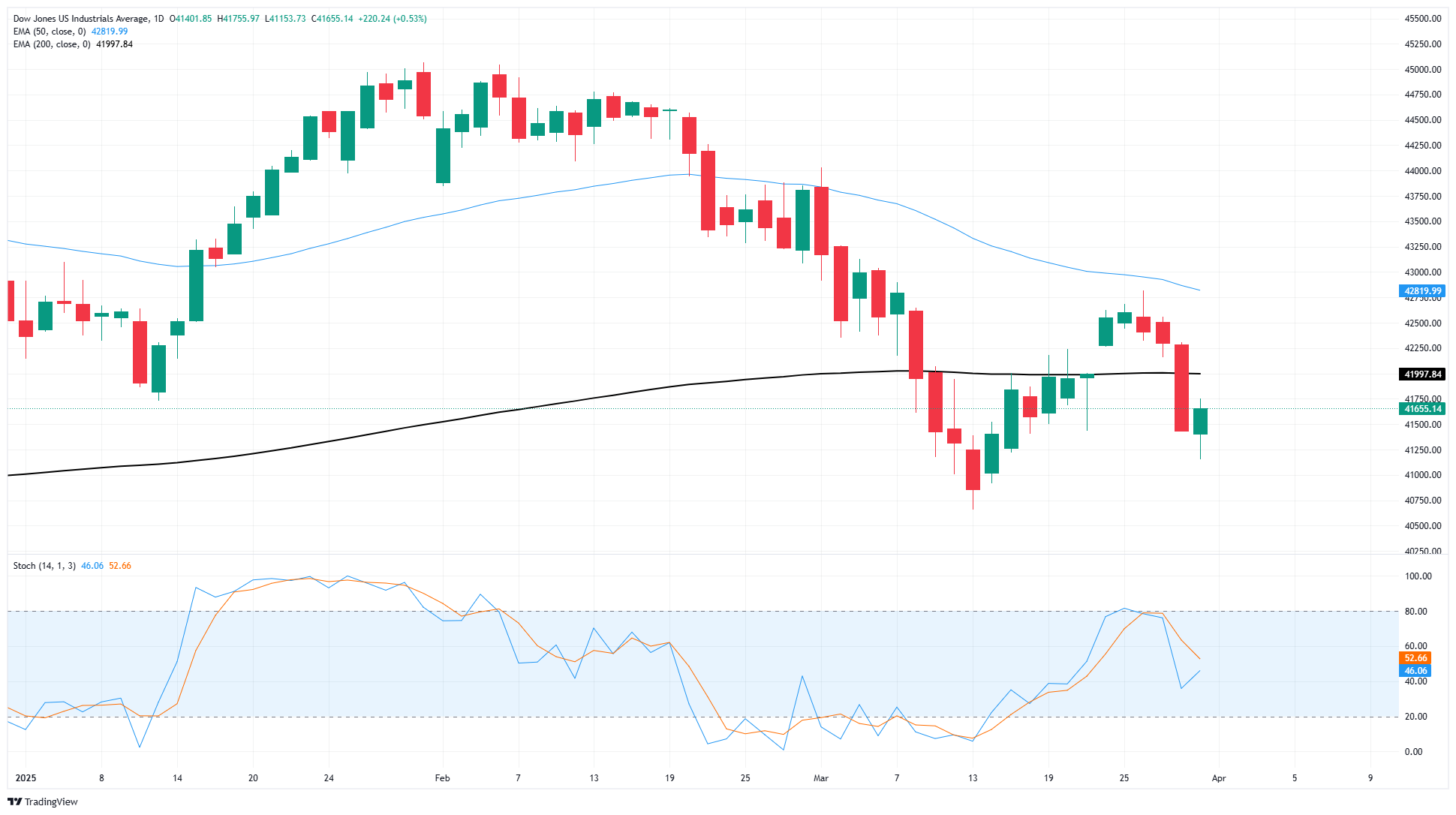Dow Jones Industrial Average climbs despite rising tariff stress
- The Dow Jones rose 0.7% on Monday as other indexes struggled.
- The Trump administration’s self-imposed April 2 deadline for tariffs looms large.
- A quiet start to the week gives way to fireworks with tariffs and NFP in the barrel.
The Dow Jones Industrial Average (DJIA) rebounded 300 points on Monday, clawing back ground that was lost in last Friday’s stock rout. United States (US) President Donald Trump is poised to unleash his long-threatened yet still-ambiguous tariff packages on April 2, crimping investor sentiment throughout the market.
The Dow Jones climbed seven-tenths of one percent, jumping back over the 41,700 level to kick off the new trading week. However, the rest of the major equity indexes continued to struggle. The Standard & Poor’s 500 eased by one-fifth of one percent to 5,570, while the tech-heavy Nasdaq Composite backslid 200 points to shed a full percent.
The Trump administration is barreling toward its self-styled deadline to kick off a wide swath of tariffs against most of the US’s trading partners. US President Donald Trump continues to brand April 2 as “Liberation Day”, and continues to insist that his administration’s plans to impose, among other various tariff threats, a 25% tariff on functionally all vehicles sold in the US and sweeping “reciprocal” tariffs on any country that has its own import restrictions on US goods. Additional tariffs are expected on the European Union (EU) and Canada, as well as any country that purchases Venezuelan Crude Oil.
US Nonfarm Payrolls (NFP) loom large later this week, slated to release on Friday. This week’s NFP could draw significant investor attention as the US economy grapples with signs of an economic slowdown, and will also serve as a bellwether labor print for after the US administration’s tariffs come into place.
Read more stock news: Apple readies large-scale revamp of health offerings
Dow Jones price forecast
The Dow Jones’ Monday recovery has snapped a three-day losing streak, pumping the brakes on near-term bearish flows. However, things aren’t exactly rosy in the viewfinder: the DJIA is still trading south of the 200-day Exponential Moving Average (EMA) near 42,080, and the major equity index is still down nearly 3% from the last swing high into 42,800.
Dow Jones daily chart
Dow Jones FAQs
The Dow Jones Industrial Average, one of the oldest stock market indices in the world, is compiled of the 30 most traded stocks in the US. The index is price-weighted rather than weighted by capitalization. It is calculated by summing the prices of the constituent stocks and dividing them by a factor, currently 0.152. The index was founded by Charles Dow, who also founded the Wall Street Journal. In later years it has been criticized for not being broadly representative enough because it only tracks 30 conglomerates, unlike broader indices such as the S&P 500.
Many different factors drive the Dow Jones Industrial Average (DJIA). The aggregate performance of the component companies revealed in quarterly company earnings reports is the main one. US and global macroeconomic data also contributes as it impacts on investor sentiment. The level of interest rates, set by the Federal Reserve (Fed), also influences the DJIA as it affects the cost of credit, on which many corporations are heavily reliant. Therefore, inflation can be a major driver as well as other metrics which impact the Fed decisions.
Dow Theory is a method for identifying the primary trend of the stock market developed by Charles Dow. A key step is to compare the direction of the Dow Jones Industrial Average (DJIA) and the Dow Jones Transportation Average (DJTA) and only follow trends where both are moving in the same direction. Volume is a confirmatory criteria. The theory uses elements of peak and trough analysis. Dow’s theory posits three trend phases: accumulation, when smart money starts buying or selling; public participation, when the wider public joins in; and distribution, when the smart money exits.
There are a number of ways to trade the DJIA. One is to use ETFs which allow investors to trade the DJIA as a single security, rather than having to buy shares in all 30 constituent companies. A leading example is the SPDR Dow Jones Industrial Average ETF (DIA). DJIA futures contracts enable traders to speculate on the future value of the index and Options provide the right, but not the obligation, to buy or sell the index at a predetermined price in the future. Mutual funds enable investors to buy a share of a diversified portfolio of DJIA stocks thus providing exposure to the overall index.


